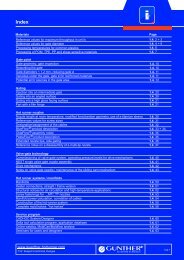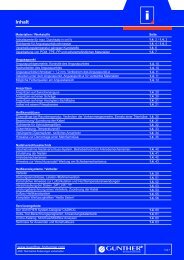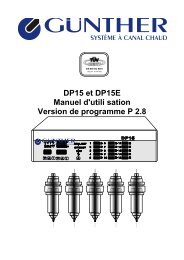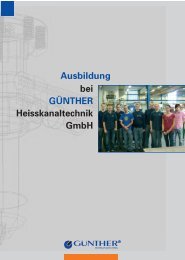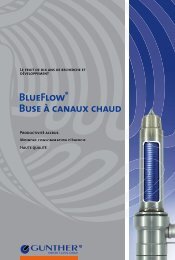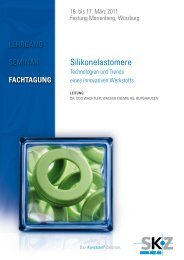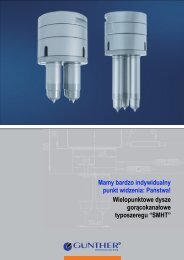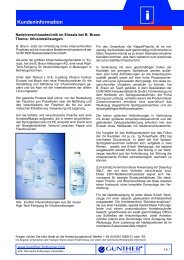Heißkanaldüsen Typ SLT/-DLT Customer information
Heißkanaldüsen Typ SLT/-DLT Customer information
Heißkanaldüsen Typ SLT/-DLT Customer information
You also want an ePaper? Increase the reach of your titles
YUMPU automatically turns print PDFs into web optimized ePapers that Google loves.
<strong>Heißkanaldüsen</strong> <strong>Typ</strong> <strong>SLT</strong>/-<strong>DLT</strong> <strong>Customer</strong> <strong>information</strong><br />
Hot runner systems for plastics filled with<br />
metal or ceramic powders<br />
Basically, conventional injection molding machines can<br />
be used for CIM and MIM. But if a manufacturer wants to<br />
use these processes on long term, wear-resistant<br />
cylinders, screws and non-return valves should be used<br />
because these components are submitted to an<br />
increased abrasion due to metal and, even to a higher<br />
extent, ceramic powders. Discussions with feedstock<br />
manufacturers and plastic processors have shown that<br />
80 to 90% of the parts produced by using MIM and CIM<br />
are manufactured by means of a cold runner with a sprue<br />
rod. A big fraction of the sprue rod can be recycled,<br />
nevertheless it would be very promising to avoid this<br />
production step by using hot runner systems.<br />
A very homogeneous temperature control in the hot<br />
runner is required, since the materials have a very small<br />
processing window. Variations of the temperature lead to<br />
a segregation of binder and powder which results in<br />
shrinkage differences and finally in the formation of<br />
cracks in the component during the sintering process.<br />
For these applications, GÜNTHER Heisskanaltechnik<br />
GmbH recommends using its hot runner nozzles e.g. of<br />
the _HT type which are designed to meet higher<br />
requirements.<br />
The patented two-stage nozzle shaft guarantees an<br />
excellent isolation at the forward section of the shaft,<br />
providing for an extremely low heat loss between hot<br />
runner nozzle and cavity, and for a very homogeneous<br />
heat distribution within the nozzle.<br />
1.5. 17<br />
Material tube<br />
(25 W/mK)<br />
Heater<br />
Air<br />
(0,04 W/mK)<br />
Gap solidified<br />
plastic<br />
(0,2...1,2 W/mK)<br />
iA<br />
Picture: The two-stage shaft of the SHT type nozzle and the frozen<br />
plastic material which forms a "cap" around the nozzle provide for<br />
optimized isolation towards the cavity and therefore produce a<br />
homogeneous temperature profile in the nozzle.<br />
Melt<br />
Shaft made of<br />
titanium alloy<br />
(7 W/mK)<br />
Open nozzle tip<br />
(100 W/mK)<br />
In addition, the frozen plastic material forms a "cap"<br />
around the nozzle, thus providing thermal separation<br />
between hot runner nozzle and cavity.<br />
However, this feature produces quite the opposite effect<br />
for metal filled plastic materials because of the metal<br />
powder conductivity. In this case the mixture of plastic<br />
material and metal powder would draw the heat off the<br />
nozzle. That's why the supplier equip the nozzles used<br />
for MIM with special insulating caps made of a highly<br />
heat resistant plastics like polyetheretherketone (PEEK)<br />
or polyimide (PI) to provide thermal separation. A tubular<br />
titanium shaft located around the hot runner nozzle<br />
additionally improves the insulating effect.<br />
This is a certain distinctive feature of the products<br />
supplied by Günther, since most of the hot runner<br />
nozzles on the market have no two-stage shaft and<br />
achieve the sealing by direct metallic contact with the<br />
material tube in the mold insert. This leads to a very high<br />
heat loss which has to be compensated by a higher<br />
temperature in the hot runner nozzle. This causes an<br />
excessive rise of the temperature as well as temperature<br />
variations, and therefore the materials cannot be<br />
processed in a reliable way.<br />
With the MIM technology, the parts are often molded by<br />
direct gating, and not via a sub-runner. Nevertheless, a<br />
relatively large gating point must be used in this case to<br />
obtain the necessary throughput and to transfer<br />
sufficient heat into the gate point. This is necessary<br />
because the metal-filled material transfers some of the<br />
heat into the cavity, and the melt freezes quickly due to<br />
the high filler content.<br />
However, with the CIM technology a sub-runner is often<br />
used. Here, too, a large gate point is of importance in<br />
order to cause as little as possible shear stress and to<br />
transfer the melt as quickly as possible into the cavity.<br />
With regard to wear resistance, hot runners have to meet<br />
severe requirements, for both MIM and CIM. The<br />
products of Günther Heisskanaltechnik have nozzle tips<br />
made of hard alloy to provide reliable wear protection.<br />
For this reason high life times are possible with no need<br />
to change components of the nozzle.<br />
For any questions, please contact our Application Engineering department at + 49 (0) 6451 5008-31 or -63.<br />
The <strong>information</strong> is given in accordance with our present-day knowledge and is meant to provide technical background.<br />
www.guenther-hotrunner.com<br />
Subject to technical changes 7/12



